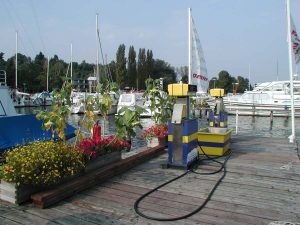
Boosting the Bottom Line
Published on January 14, 2024In conversations and discussion, we often hear the phrase, “that’s the bottom line.” But it is more than a phrase, it is essentially the final result and, in accounting, whether your bottom line is black or red it is often the difference between making a go of it or financially failing. It’s no wonder, then, that we are often looking for ways to give the bottom line a boost.
I have worked in multiple industries, and while I love, respect, and am intrigued with the recreational marina industry, the one thing that stands out across the various continents is that the industry continually underprices the true costs of the services that are provided.
While I was at the World Marinas Conference in Portugal this year I made this remark, and in response a well-respected marina leader from a non-western continent made the remark, “Wow, I can get larger financing and am worth more.” While it might have been a somewhat facetious remark, it can be very true. The better the financial picture, the easier it is to get financing, as well as more desirable rates, for improvements to the facility.
I am often told by marina owners and operators such things as, “We cannot charge more or our customers will leave,” or “The market cannot support higher pricing,” and similar remarks. And that may be partially true. But I am a firm believer that boaters–particularly the newer boaters–are willing to pay the full freight if they perceive value in what they are paying for.
Know Your Demographics
The new demographics suggest that boaters are more demanding, have higher expectations, have little to no tolerance for things not working, and want to be treated as if they are special. In return, they are willing to pay the full freight – but they need to perceive they are getting value for their money.

I recently had a planning discussion with a marina operator who has come from another industry. His comment was, “I have to continually pay a lot more to our mechanics and key strategic employees in order to keep them – but our labor rates to customers are well below what it is costing us.” I asked him what his labor rates were compared to nearby automotive labor rates, or his plumber’s or electrician’s rates. He knew it was below the automotive posted labor rates but was unsure about the others. I suggested he might want to check them out, because I could guarantee they were all much higher than the marina’s posted labor rates. When he thought about it his comment was, “Well, if I raise them, then the customers will go to others.” A fair vantagepoint … but only if one looks at just part of the picture.
Sometimes the customer that would leave due to fair price increases may not be the customer that you want. And to be clear, we do not suggest making abrupt, staggering price increases, but to routinely adjusting pricing up to keep rates at desirable levels. The longer one waits to raise prices, the harder it is to catch up to where they should be.
I am reminded of a chain that was the most profitable in the country, and during the economically depressed times when most marinas were 10% to 50% full, his marinas were between 90% to 100% full, with rates between 20% and 25% higher than the others. I would walk his docks and talk with customers seeking to find out why they stayed at the marina when they could literally go next door with cheaper pricing. Their responses were all relatively uniform, “The marina cares about me,” or “They do it right and guarantee their work,” and “I can call, and they will take care of what I’m asking for …. I don’t have to worry about down time or excuses, they do it right.”
In short, they perceived value for what they were paying for. The managers knew the customers by their first names, and they specialized in providing personal service. They would have the manager or service mechanic call the customer and keep him/her posted as to what they were doing and whether they had run into problems or anything else that needed or should have attention.
Personal Touch Makes a Difference
There are many different business models that can boost the bottom line, and there is no “one shoe fits all.” One has to know one’s customers – not just from the marina’s vantage point, but, more importantly, from that of the customers.
What we find is that the perception of “nickel and diming” customers is a trigger for disenchantment. Bundling and explaining goes a long way to relieving the pain of higher costs.
Going above and beyond is a great way to build customer loyalty and acceptance of higher pricing. For example, when a customer comes in for some engine, hull or other work – whether it’s minor or major – if you can do a quick cleanup of the boat, maybe including polishing the topsides or some chrome, it gives the customer the impression that you care. No matter where in the world this is done, customers tell me that it makes a major, lasting impression on them. The perception is that the customer is being treated as special, and not paying extra for that extra service, though in fact it is already built into the rate the marina is charging. A win-win for all.
But a key element is communication with the customer—visually, verbally, and in-writing. Presenting an inviting entrance and facility is one main visual approach. Take the opportunity to engage with customers and let them know what improvements have been undertaken, are under way, and being contemplated. These steps are key to keeping the customer informed, engaged, and appreciative of what is taking place.
As marinas are trying to upgrade the facility, whether by dredging or undertaking other significant financial investments, communicating that to customers is important. This is particularly important when the projects involve things that customers may not easily see, like dredging or utility upgrades. Be sure to include why the project matters and how it will improve the customer experience. In this way customers will be able to relate to the improvements being undertaken and better understand that they have to be paid for. It eases the pain of increasing pricing. Seeking customer input as to what they want, and then providing it in some meaningful way, shape or form, is always a great way to try to get them to “buy into” the program.
Aesthetically Pleasing
Improving the aesthetics of the facility with plantings and a thorough cleanup goes a long way to making people feel comfortable and wanting to be at the facility – and more willing to pay for being there.
Keep in mind that many customers are also willing to pay more for the green/organic/more environmentally friendly approaches. Chances are the greener you can make the facility the more you will be able to charge for its use – and in many cases the more you can reduce long-term costs, particularly when it comes to things like energy use.
Another way to boost the bottom line is to review one’s operating and capital budgets together –and look at how much one is constantly paying for the same repairs versus what it would cost for replacement, and what would be the payback. As part of that analysis, also factor in the replacement/improvement option may well allow you more opportunity to recoup the costs through higher rates than the ongoing maintenance.
Involving staff in these discussions can be very meaningful. Many staff members are aware of potential cost-saving activities but are not necessarily comfortable in being forthcoming unless brought into the process and encouraged.
The Bottom Line
One of the best ways to boost the bottom line is when customers bring their boats in for work. Most boaters are working or otherwise busy during the day. Calling the customer when the boat is being worked on and inviting them to meet in the evening or at a particular time or day to review what is being done usually turns into a friendly conversation, and then the, “oh, by the way…” there is this noise or rattle or lever or something else that needs adjustment or attention and the customer has been meaning to have you look at it. These add-ons can easily add anywhere from 10% to as much as 50% or more to the total of the original work order – and it is found money that otherwise would not be on the table. More importantly, the customer feels that you have gone out of your way to be helpful and meaningful.
And of course, one of the most customer-appreciated approaches is for the marina to have an event, such as a customer appreciation day or a holiday party. It is a great way for customers to socialize with other boaters, as well as for them to have time to talk with your staff, and, most importantly, with you.
Dan Natchez, CMP, is president of DANIEL S. NATCHEZ and ASSOCIATES Inc. He can be contacted by phone at 914-698-5678, by email at dan.n@dsnainc.com or online at www.dsnainc.com.
| Categories | |
| Tags |





